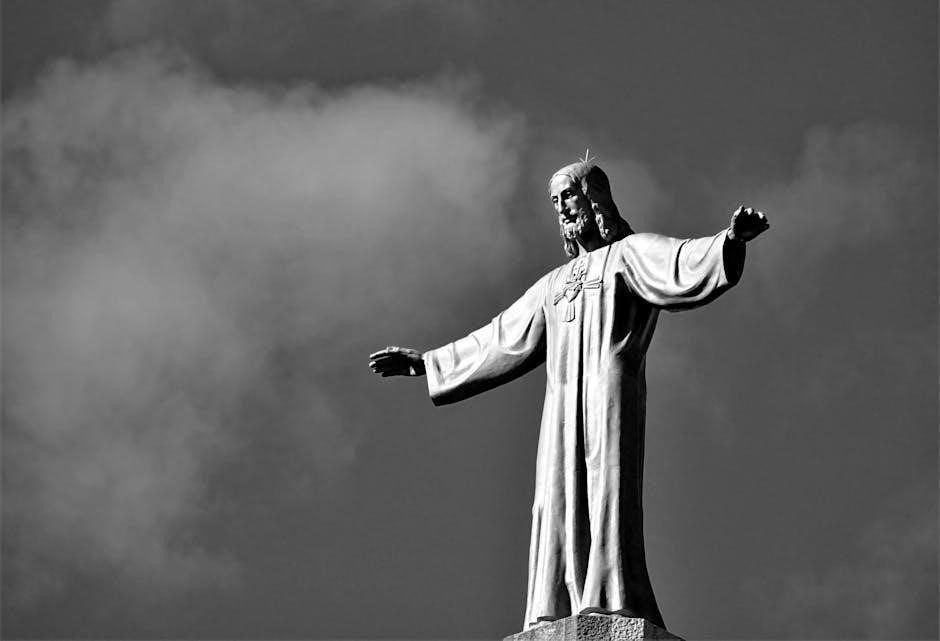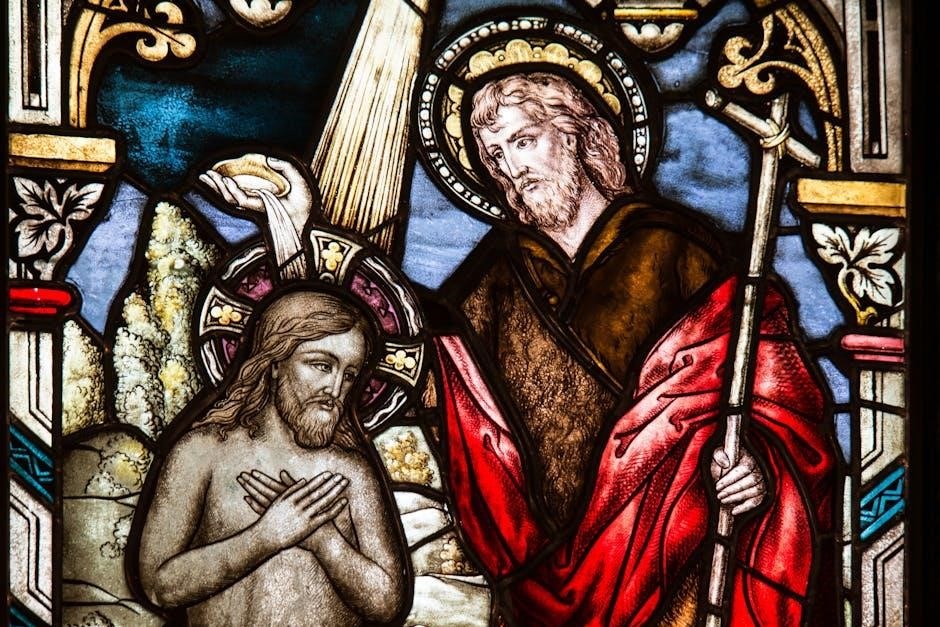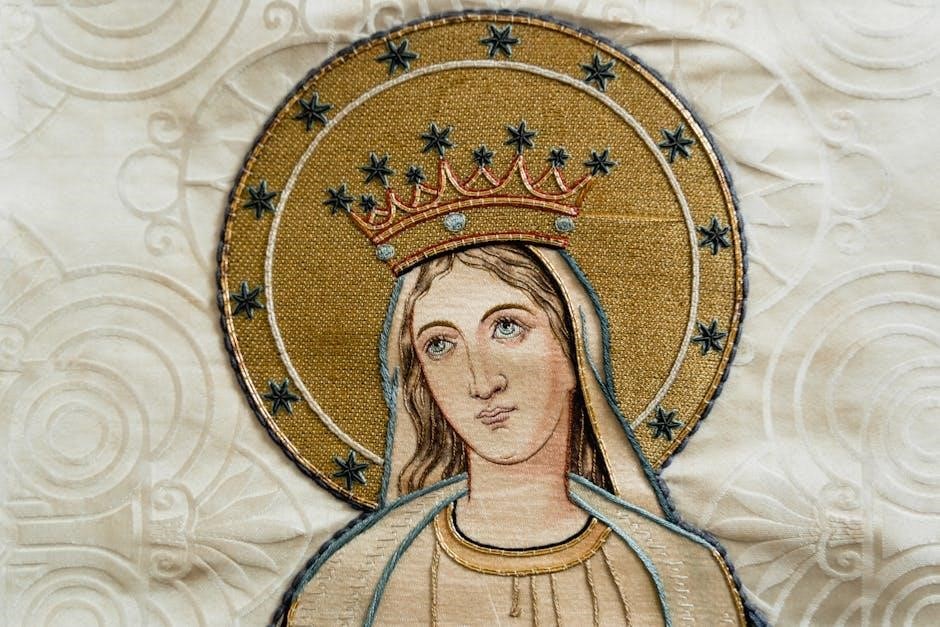Howard Thurman’s 1949 book explores Jesus’ relevance to marginalized communities, offering a theological framework for liberation and social justice, influencing the civil rights movement and leaders like Martin Luther King Jr.
1.1 Overview of the Book
Jesus and the Disinherited by Howard Thurman, published in 1949, is a seminal work exploring Jesus’ teachings in the context of marginalization and oppression. The book delves into themes of fear, deception, hate, and love, offering a theological framework for liberation. It questions how Jesus’ message can empower the oppressed and the disinherited. Thurman’s insights have profoundly influenced movements like the civil rights struggle, shaping leaders such as Martin Luther King Jr. The book remains a powerful critique of societal injustices, advocating for love and inclusion as transformative forces. Available as a PDF from sources like Beacon Press and Z-Library, it continues to inspire contemporary theology and social justice efforts.
1.2 Author Background: Howard Thurman
Howard Thurman was a renowned American theologian, educator, and civil rights leader. Born in 1899, Thurman played a pivotal role in shaping the intersection of spirituality and social justice. He served as the Dean of Marsh Chapel at Boston University and was a mentor to prominent figures like Martin Luther King Jr. Thurman’s writings, particularly Jesus and the Disinherited, emphasized the transformative power of love and the relevance of Jesus’ teachings for marginalized communities. His work bridged theology and activism, inspiring movements for racial equality and human dignity; Thurman’s legacy endures as a cornerstone of modern theology and social justice advocacy, with his book remaining a timeless resource for understanding oppression and liberation.
1.3 Historical Context of the Book
Jesus and the Disinherited was written by Howard Thurman in 1949, a pivotal time in American history marked by racial segregation and social inequality. The book emerged during the early stages of the civil rights movement, offering a theological response to systemic oppression. Thurman, deeply influenced by his experiences as a Black man in America, crafted a message of hope and liberation through the lens of Jesus’ teachings. The book’s release coincided with growing activism for racial justice, making it a seminal work that resonated with leaders like Martin Luther King Jr. Its historical context underscores the urgent need for spiritual and social transformation, positioning it as a foundational text for understanding the intersection of faith and activism during the mid-20th century.

Key Themes in “Jesus and the Disinherited”
The book explores themes of fear, deception, hate, and love, emphasizing Jesus’ solidarity with the marginalized and the transformative power of inclusive love and justice.
2.1 The Concept of the Disinherited
Howard Thurman defines the disinherited as those marginalized by society, including the poor, oppressed, and powerless. Jesus, as a member of an oppressed group, understood their struggles deeply. Thurman argues that Jesus’ teachings were specifically directed toward these individuals, offering them hope and liberation. The disinherited are characterized by their lack of material resources, social exclusion, and systemic injustice. Thurman emphasizes that Jesus’ identification with the disinherited underscores his message of love, justice, and redemption. This concept is central to the book, as it highlights the transformative power of faith for those on the fringes of society, providing a theological foundation for social change and equality.
2.2 The Role of Fear in Society
Fear is identified by Thurman as one of the persistent “hounds of hell” that plague the disinherited, perpetuating oppression and social division. It manifests as fear of the unknown, fear of change, and fear of those perceived as different. This fear often leads to hatred and violence, creating a cycle of suffering. Thurman argues that Jesus confronted fear in his teachings, emphasizing love and courage as antidotes. By addressing fear, Jesus offered a path to liberation, not just for the disinherited, but for all individuals trapped in its grip. Thurman’s analysis highlights fear’s destructive power and the necessity of overcoming it to achieve true social justice and human dignity.
2.3 The Power of Love and Inclusion
Thurman emphasizes Jesus’ teachings on love as a transformative force, particularly for the disinherited. Love, in this context, is not passive but active, demanding radical inclusion and compassion. Jesus’ ministry exemplified this by embracing the marginalized, challenging societal norms, and fostering community. Thurman argues that love has the power to dismantle fear, hatred, and deception, creating a society where the oppressed can find dignity and hope. This theme of inclusion is central to Jesus’ message, offering a vision of a world where love transcends division and restores humanity. Thurman’s exploration of love as a liberating force remains a cornerstone of his theology, inspiring social change and unity.
2.4 The Intersection of Religion and Social Justice
Thurman explores the inseparable link between religion and social justice, arguing that true spirituality must address the plight of the marginalized. Jesus’ ministry, focused on the poor and oppressed, demonstrates that religion is not merely personal but inherently tied to societal transformation. Thurman critiques the church for often neglecting its role in advocating for justice, instead aligning with oppressive systems. He calls for a faith that actively challenges inequality, advocating for the liberation of the disinherited. This intersection of religion and justice is not optional but central to Jesus’ teachings, emphasizing that love for God is expressed through love for neighbor and the pursuit of a just society.

Chapter Analysis
The book is divided into five chapters, each exploring themes of oppression, fear, deception, hate, and love, providing a theological framework for understanding the disinherited’s struggle.
3.1 Chapter 1: The Setting

Chapter 1 of “Jesus and the Disinherited” sets the stage by examining Jesus within his historical and social context. Thurman portrays Jesus as a member of the disinherited, emphasizing his connection to the poor, the oppressed, and the marginalized. By situating Jesus in a world marked by political domination and social inequality, Thurman highlights how Jesus’ teachings were shaped by his lived experience as an outsider. This chapter establishes the foundation for understanding Jesus’ message as one of liberation and hope for those on the fringes of society. It underscores the importance of context in interpreting Jesus’ teachings, making his message relevant to the disinherited of all eras.
3.2 Chapter 2: Fear
Chapter 2 delves into the pervasive role of fear in the lives of the disinherited, identifying it as one of the “hounds of hell” that perpetuates oppression. Thurman argues that fear is both a natural human emotion and a tool exploited by those in power to maintain control over marginalized communities. He examines how fear manifests in the lives of the oppressed, leading to internalized oppression and division. Jesus, according to Thurman, confronts fear by offering a countercultural message of love, courage, and solidarity with the marginalized. This chapter underscores the psychological and social dimensions of fear and its implications for liberation, emphasizing Jesus’ role in transforming fear into hope and action.
3.3 Chapter 3: Deception
Chapter 3 explores deception as a tool of oppression, highlighting its role in maintaining power imbalances. Thurman argues that deception distorts reality, concealing the truth from the disinherited and perpetuating their exploitation. He examines how societal structures and religious institutions often use deception to justify inequality, creating a false narrative that marginalizes the oppressed. Jesus, in contrast, embodies truth and transparency, confronting deception head-on. Thurman emphasizes the need for the disinherited to recognize and reject deception, embracing instead the liberating truth of Jesus’ teachings. This chapter challenges readers to critically discern deception and align themselves with authenticity and justice, central to Jesus’ message of liberation and inclusion.
3;4 Chapter 4: Hate
Chapter 4 delves into hate as a destructive force that perpetuates division and dehumanization. Thurman argues that hate is a weapon used to oppress the disinherited, fostering cycles of violence and alienation. He examines how hate is rooted in fear and ignorance, often disguised as righteousness. Jesus, however, rejects hate, advocating for love and compassion even toward enemies. Thurman emphasizes that true liberation requires overcoming hate, not through vengeance but through understanding and forgiveness. This chapter challenges readers to confront the pervasive nature of hate in society and to embrace Jesus’ radical teachings of love as a transformative force for justice and reconciliation.
3.5 Chapter 5: Love
Chapter 5 explores love as a transformative and radical force in the face of oppression. Thurman argues that Jesus’ teachings on love are not passive but active, requiring individuals to stand against injustice and affirm the dignity of all people. Love, in this context, is not sentimental but a commitment to justice and compassion. Thurman emphasizes that love must be expressed in actions that challenge systems of oppression and empower the disinherited. He suggests that love, as exemplified by Jesus, has the power to dismantle fear, hate, and deception, creating a society rooted in equality and mutual respect. This chapter underscores love as a revolutionary ethic for personal and societal transformation.

Theological Insights

Thurman explores Jesus as a symbol of the disinherited, emphasizing his teachings’ relevance to marginalized communities. He distinguishes the religion of Jesus from institutional Christianity, highlighting love and inclusion as central tenets.
4.1 Jesus as a Symbol of the Disinherited
Howard Thurman portrays Jesus as a symbol of the disinherited, emphasizing his identification with the marginalized and oppressed. Jesus, as a poor Jew under Roman domination, understood the struggles of the disinherited. Thurman highlights how Jesus’ teachings and actions were directed toward those on the fringes of society, offering them hope and liberation. By focusing on Jesus’ solidarity with the oppressed, Thurman underscores his role as a spiritual leader who challenged systemic injustice. This interpretation resonates deeply with those experiencing exclusion, providing a theological foundation for liberation and empowerment. Thurman’s portrayal of Jesus as a symbol of the disinherited remains a powerful framework for understanding the intersection of faith and social justice.
4.2 The Religion of Jesus vs. the Religion of the Church
Howard Thurman’s “Jesus and the Disinherited” differentiates between the religion of Jesus and the religion of the Church. The religion of Jesus is rooted in His teachings of love, compassion, and solidarity with the marginalized, emphasizing personal transformation and a direct relationship with God. In contrast, the religion of the Church often refers to institutional practices, doctrines, and hierarchies that have evolved over time. Thurman argues that the Church’s religion can become entangled with power structures, sometimes losing sight of Jesus’ core message of liberation and inclusion. This distinction is crucial for understanding Jesus’ true mission and the divergence between His teachings and institutionalized Christianity, highlighting the need to return to the essence of His message for genuine spiritual renewal.
4.3 The Role of the Cross in Liberation
In “Jesus and the Disinherited,” Howard Thurman interprets the cross as a symbol of liberation, emphasizing Jesus’ willingness to confront systemic oppression and injustice. Thurman argues that the cross represents the ultimate act of love and sacrifice, demonstrating God’s solidarity with the marginalized. For the disinherited, the cross becomes a source of empowerment, offering hope and resistance against oppressive systems. Thurman distinguishes between the cross as a tool of liberation and the crucifixion as an act of state-sponsored violence, highlighting its transformative power for those seeking justice. This interpretation challenges readers to embrace the cross not as a symbol of resignation but as a call to active resistance against injustice, aligning with the struggles of the oppressed and disenfranchised.

Social and Political Implications
Thurman’s work profoundly influenced the civil rights movement, inspiring leaders like Martin Luther King Jr. to embrace nonviolent resistance and advocate for social justice and equality.
5.1 The Book’s Influence on the Civil Rights Movement
Jesus and the Disinherited became a cornerstone of the civil rights movement, inspiring leaders like Martin Luther King Jr. with its message of nonviolent resistance and love. Thurman’s emphasis on addressing fear, deception, and hate resonated deeply, offering a spiritual foundation for activism. The book’s focus on the marginalized aligned with the movement’s goals, providing theological justification for fighting oppression. Its teachings on love and inclusion empowered activists to confront injustice nonviolently, shaping the moral and strategic framework of the movement. This influence cemented the book’s legacy as a pivotal text in the struggle for equality and human dignity.
5.2 Martin Luther King Jr. and Howard Thurman
Martin Luther King Jr. was deeply influenced by Howard Thurman’s Jesus and the Disinherited, which shaped his theological and philosophical approach to civil rights activism. Thurman, a mentor to King, emphasized the power of love and nonviolence in combating oppression. His teachings resonated with King, who often referenced the book in his sermons and writings. The concept of Jesus as a symbol of the disinherited aligned with King’s vision of justice for the marginalized. Their shared commitment to nonviolent resistance and spiritual transformation left a lasting legacy in the civil rights movement, forever linking their work in the pursuit of equality and human dignity.
5.3 The Relevance of the Book Today
Jesus and the Disinherited remains a powerful and timely work, addressing systemic inequality, injustice, and division—issues as relevant today as in Thurman’s time. Its exploration of fear, deception, and hate as tools of oppression continues to resonate, offering insights into modern societal struggles. Thurman’s emphasis on love, inclusion, and the transformative power of religion aligns with contemporary movements for social justice. The book’s call to reclaim Jesus’ message for the marginalized inspires activism and theological reflection. Its timeless themes make it a vital resource for understanding and addressing ongoing disparities, ensuring its relevance in today’s world of social and political polarization.

Critical Reception and Reviews
Jesus and the Disinherited has received widespread acclaim for its profound theological insights and social relevance. Scholars praise its nuanced exploration of Jesus’ message for the marginalized, while the PDF version’s accessibility has broadened its impact, resonating with contemporary readers seeking inspiration for justice and inclusion.
6.1 Scholarly Reviews and Analysis
Scholars have widely praised Jesus and the Disinherited for its profound theological insights and historical context. The book is noted for its exploration of Jesus’ teachings as a source of empowerment for marginalized communities. Many analysts highlight Thurman’s ability to bridge the gap between religious doctrine and social justice, offering a fresh perspective on the role of spirituality in combating oppression. The PDF version has been particularly praised for its accessibility, allowing a broader audience to engage with Thurman’s seminal work. Academic reviews frequently emphasize the book’s enduring relevance, making it a cornerstone of modern theological studies and civil rights discourse.
6.2 Public Reception and Impact
Jesus and the Disinherited has resonated deeply with the public, particularly among marginalized communities, for its empowering message of love and inclusion. The book’s influence on the civil rights movement is well-documented, inspiring leaders like Martin Luther King Jr. Its accessible language and profound insights have made it a beloved resource for both religious and secular audiences. The PDF version has further expanded its reach, allowing global access to Thurman’s transformative ideas. Many readers credit the book with fostering personal and societal change, emphasizing its timeless relevance in addressing inequality and injustice. Its enduring popularity underscores its role as a spiritual and ethical guide for modern audiences seeking liberation and hope.
6.3 Criticisms and Controversies
While Jesus and the Disinherited is widely acclaimed, some critics argue that its focus on spirituality may overlook systemic structures of oppression. Others suggest that Thurman’s emphasis on nonviolent resistance, though influential, may not fully address the complexities of modern activism. Additionally, a few scholars have critiqued the book’s accessible language as overly simplistic, potentially limiting its depth for theological scholars. Despite these criticisms, the book’s enduring relevance and emotional resonance continue to make it a powerful resource for exploring themes of justice and liberation. Its controversial aspects often spark important discussions, ensuring its place as a thought-provoking work in religious and social discourse.

Practical Applications
Jesus and the Disinherited inspires modern social justice efforts, offering teachings applicable to education, community empowerment, and personal reflection. Its principles continue to guide activism and theological studies globally.
7.1 Applying the Teachings in Modern Society
Jesus and the Disinherited offers timeless wisdom for addressing modern societal challenges. Its teachings on love, inclusion, and resistance to oppression inspire movements for racial and economic justice. Educators use the book to foster empathy and critical thinking, while activists apply its principles to community organizing and advocacy. The emphasis on Jesus’ solidarity with the marginalized encourages individuals to confront systemic inequities. By integrating these insights into personal and collective action, modern society can move toward a more just and compassionate world, reflecting Thurman’s vision of liberation and hope for all people.
7.2 The Book’s Influence on Contemporary Theology
Jesus and the Disinherited has profoundly shaped contemporary theology by emphasizing Jesus’ solidarity with the marginalized. It bridges spiritual teachings with social justice, inspiring liberation theology and modern religious movements. The book’s focus on love, fear, and deception resonates with theologians addressing systemic inequities. Many scholars and faith leaders integrate Thurman’s insights into their work, advocating for a more inclusive and compassionate Christianity. Its relevance endures, influencing debates on race, poverty, and justice. By centering the experiences of the disinherited, the book remains a vital text for theologians seeking to align faith with activism and societal transformation.
7.3 Using the Book in Educational Settings
Jesus and the Disinherited is widely used in educational settings to explore themes of social justice, theology, and ethics. Professors often incorporate it into syllabi for courses on religion, sociology, and activism. The book’s accessible language and profound insights make it ideal for sparking discussions on inequality, fear, and love. Many educators use the free PDF version available online, ensuring accessibility for students. Its relevance to contemporary issues encourages critical thinking and reflection. Additionally, the text is often paired with case studies or reflection questions to deepen understanding. By integrating this work, educators help students connect theological concepts with real-world applications, fostering empathy and a commitment to justice.

Download and Access Information
The book is available as a free PDF download on platforms like Z-Library and educational websites, ensuring accessibility for readers worldwide.
8.1 Where to Find the PDF Version
The PDF version of Jesus and the Disinherited by Howard Thurman can be found on various online platforms. Z-Library offers a free download, while educational websites like Digital Library of India provide access to the book. Additionally, some theological seminary websites and academic databases host the PDF for research purposes. Users can also find downloadable links through platforms like ResearchGate and online archives. For convenience, the book is available in multiple formats, including EPUB and text files, ensuring accessibility for diverse readers. Purchasing options are also available through Beacon Press and other major bookstores. Always ensure to use reputable sources to access or download the PDF legally and ethically.
8.2 Free Download Options
Several platforms offer free downloads of Jesus and the Disinherited in PDF format. Z-Library provides access to the book for free, allowing users to download it as a PDF or text file. Additionally, websites like Digital Library of India and ResearchGate host the book for academic and personal use. Some theological institutions and online archives also offer free PDF versions for educational purposes. Users can search for reliable sources to ensure they are accessing the book legally and ethically. These options make Thurman’s work widely accessible, enabling readers to engage with its profound insights on liberation and social justice. Always verify the credibility of the source before downloading.
8.3 Purchasing the Book
Jesus and the Disinherited is widely available for purchase in various formats. The book can be bought in paperback or hardcover from major retailers like Amazon, Barnes & Noble, and indie bookstores. Digital versions, including eBooks, are also accessible through platforms like Amazon Kindle and Google Books. Beacon Press, the original publisher, offers direct purchases on their website. Additionally, many theological seminaries and online bookstores carry the title. Purchasing the book supports the publisher and ensures high-quality prints. It’s advisable to buy from reputable sources to avoid unauthorized editions. This timeless work remains a vital resource for those exploring faith and social justice, making it a worthwhile investment for personal or academic libraries.
Howard Thurman’s Jesus and the Disinherited profoundly influenced the civil rights movement, emphasizing love over fear and advocating for social justice, remaining a powerful text for modern liberation.
9.1 Summary of Key Points
Jesus and the Disinherited by Howard Thurman explores Jesus’ teachings through the lens of marginalization, emphasizing liberation from fear, deception, and hate. Thurman, a pivotal theologian, highlights love and inclusion as transformative forces. The book, influential during the civil rights movement, inspired leaders like Martin Luther King Jr., offering a powerful theological framework for social justice. First published in 1949, it remains relevant today, addressing systemic oppression and advocating for equality. Thurman’s work bridges religion and activism, providing a compelling narrative for the disinherited. The PDF version is widely accessible, ensuring its message of hope and liberation continues to resonate with modern readers.
9.2 Final Thoughts on the Book’s Significance
Jesus and the Disinherited remains a profound theological and social commentary, offering timeless insights into liberation and justice. Howard Thurman’s work bridges the gap between faith and activism, resonating deeply with marginalized communities. Its influence on the civil rights movement, particularly on leaders like Martin Luther King Jr., underscores its historical importance. The book’s emphasis on love, inclusion, and resistance to oppression continues to inspire modern readers. As a PDF, its accessibility ensures its message of hope and empowerment reaches a global audience, solidifying its legacy as a cornerstone of liberation theology and social justice literature.
